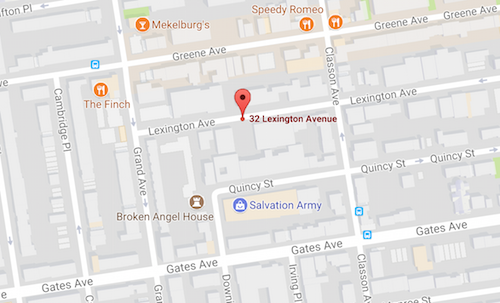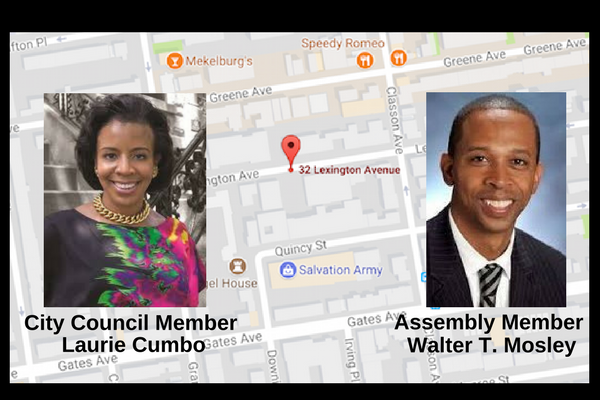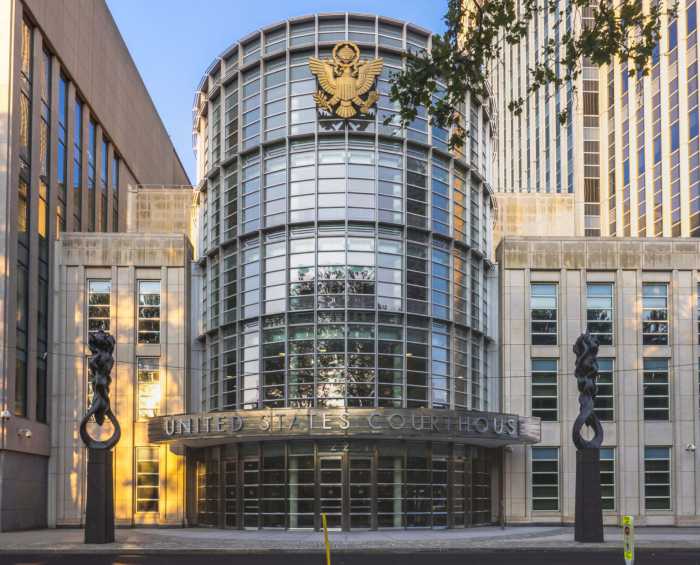The group waited over eight hours but they weren’t going to be denied to have their voices heard.
Fort Green/Clinton Hill lawmakers Assemblyman Walter T. Mosley and City Councilwoman Laurie Cumbo last week joined Clinton Hill residents in fighting a controversial development in their historic neighborhood.
The group traveled west into Manhattan and waited over eight hours to testify in front of the Board of Standards and Appeals (BSA) to challenge the development of a 10-story high mega building at 32 Lexington Avenue, currently a parking lot sitting in a low-rise neighborhood and sitting behind a fixed, low-income apartment building.
IMPACT Brooklyn, a non-profit housing advocacy group, owns the property and is seeking approval for five zoning variances that would allow a new charter high school and housing. It is in the middle of an already congested, one-way street of low-flung homes flanked by Classon Street and Grand Avenue, which are also one-way streets.

“The neighborhood in which this building would be situated is predominantly low-rise, and a building like the one proposed would block natural sunlight and cast shadows in undesirable locations. There has been an uncharacteristic amount of variance requests in order to make this building possible, which should give us all pause. If this building cannot be built within the current zoning of the neighborhood, it should not be built at all,” said Mosley.
The lawmakers and residents argued before the board that the proposed variances go against Mayor Bill de Blasio’s tenets of contextual zoning that the City Council enacted in 2014 as a way to build more affordable housing while maintaining the integrity and quality of city neighborhoods.
At the meeting, the board and community members expressed their deep concern for the development, claiming the developer has already used up all of their development rights available at the site with 15 Quincy Street and is attempting to double dip. 15 Quincy Street is a 48 unit, below market-rate, low-rise apartment building, built by the same developer.
The landscape of housing in Clinton Hill only rise as high as 55 feet. As a result, a 101-foot building out of context building would not cause obstructed views, but also change the landscape of the neighborhood. According to current residents, the new charter school would completely block the majority of their outdoor views, making sunlight into their homes nearly impossible.

“Our neighborhood is under siege and with the vertical boom happening in areas in downtown Brooklyn near Atlantic Avenue and Fulton Street, developers are moving into residential neighborhoods and slowly changing the landscape,” said Cumbo. “We as a community have seen developers who are not shy about constructing towers that are out-of-scale with the surrounding structures. At 32 Lexington Avenue, I cannot express how gravely opposed I am to a 101-foot structure being erected at this location.”
Residents also argue that with a high school that is projected to have over 400 students in the center of their small dead-end street, the influx of teachers, students and parents will create even more undue congestion.

“Our apartment is one of twenty-four where the only windows – in our bedroom and our living area – are rear-facing directly onto the location of this proposed 101-ft school tower, just 45 feet away from our windows,” said Eva Browne, a senior and resident of 15 Quincy Street. “If this school is built, our sunlight will be blocked. Because of the need to keep our lights on or our air conditioning running, I know we will be forced from our home due to costs; we live on a fixed income.”
In May of 2017, Community Board #2 in Brooklyn voted to recommend that the BSA disapprove the applications for variances.
“This part of Clinton Hill has a mix of residential and industrial uses in buildings from a variety of periods and in a range of styles, but that is not the same as characterless. It is a questionable argument to equate a lack of uniformity with ‘anything goes.’ Renderings of the proposed building show it to be aesthetically out-of-character with the neighborhood and quite simply too tall,” said CB2 District Manager Robert Perris.
At last week’s hearing, the board requested written submissions from the developer addressing the questions and concerns that the chair, other members of the board, the lawmakers and the residents had raised.
The development is scheduled for further discussion at a second hearing on February 27, 2018.






